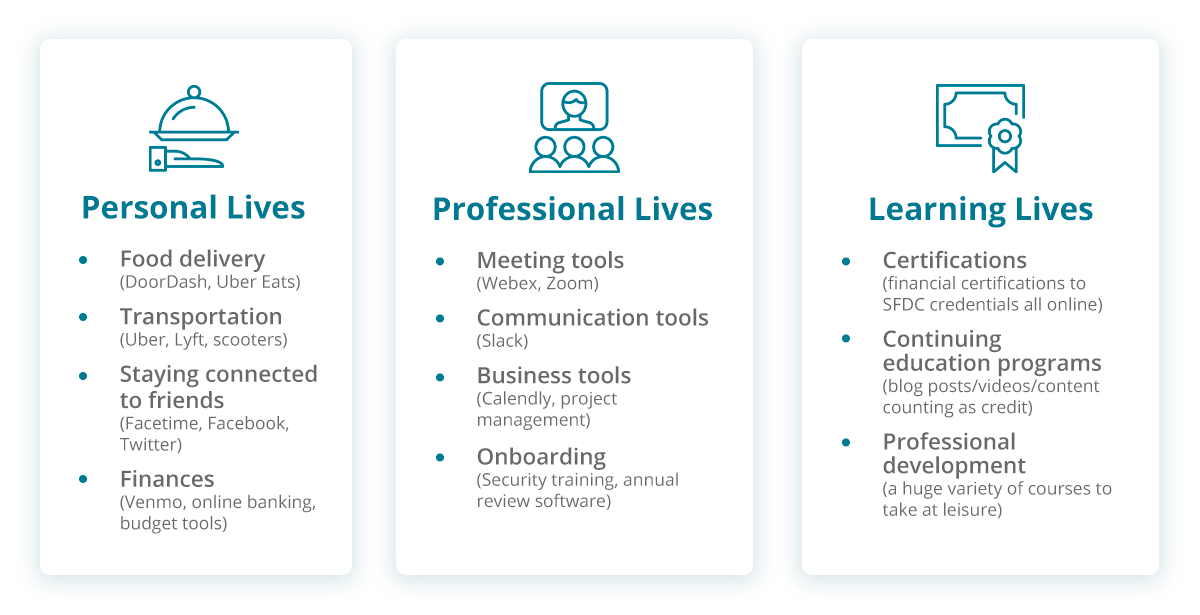5 Key Factors Driving Digital Transformation In Professional Learning [Webinar Recap]
Digital transformation is a leading force that is changing the way businesses function today. It’s more than a trend. As a training program leader, it’s something that should be at the top of your priority list.
When you look at the rapidly changing world around you, it’s clear that many professionals in the training industry are rushing to get on board with digital transformation. Are you ready to adapt, or will you risk becoming obsolete?
In a recent webinar with Association for Talent Development, we revealed five factors driving digital transformation in professional learning and how digital transformation will have a profound impact on how you conduct your business in 2021 and beyond. Here are the highlights from this webinar:
What is Digital Transformation?
Digital transformation is undeniably here.
At the end of the day, the status quo won’t cut it in business anymore. You have a choice: you can be the organization that pretends nothing has changed, or you can accept the change and adapt. This big decision will ultimately decide which learning businesses thrive and which will be left behind.
It’s a process representing tremendous, paradigm-shifting change where organizations uncover new solutions to previously intractable problems.
Be careful not to confuse digital transformation with the similar-sounding terms digitization and digitalization. These terms are related,but they do have different meanings and can have different effects on your business. It’s helpful to think of them as a progression toward digital maturity. Here’s the difference between these terms:
- Digitization: Transforms information
- Digitalization: Transforms processes
- Digital Transformation: Transforms everything
Factor #1: Blurring the lines between digital and physical lives
Life as we know it is becoming all digital. There is an app for almost everything, and across the world, people can manage nearly every aspect of their lives from their phones, tablets, or computers.
If you don’t believe us, here’s are some ways how digital transformation is shaping our personal, professional, and learning lives:

It seems like the whole world is coming aboard the digital transformation train, but in reality, there are still a few industries that are behind the train tracks. One of those industries is the education space.
Currently, less than 4% of education spending is digital. This means a whopping 96% of the industry is ripe for change and adaptation. Digital transformation will always remain at the forefront of how we live, work, and conduct business, and soon enough the education sector will need to embrace the change in order to stay relevant.
Factor #2: Expectations of Modern Learners
Digital transformation in the professional learning space is absolutely being driven by the expectations of modern learners.. Who is the modern learner?
The modern learner isn’t defined by their age or demographic but rather by their habits, dispositions, and most importantly their ideas about the rapidly changing world in which they now live. Modern learners have seen the ways that our digital and physical lives blur together, and they’ve come to expect that from their professional learning experiences.
Only by understanding the needs of modern learners will you be able to help them succeed. Here are some things you need to know about the modern learner:
- They are distracted: With millions of apps, websites, and videos, modern learners are unlocking their phones at least 9 times every hour.
- They are overwhelmed: Today’s learners are being asked to do more with less, and the work has accelerated, leaving many of them overwhelmed.
- They are collaborative: 80% of learning happens when workers interact with peers on the job. Learners more than ever are asking others questions and sharing what they know.
- They are keen to learn: Learners aren’t sitting back waiting for an opportunity to learn, they are actively seeking them out through peers, learning sources, and more.
Learners are becoming conditioned to think differently, interact differently, and have different expectations regarding how they’ll learn. And with this shift we are seeing with the new needs of the modern learner, and it’s clear that digital learning is here to stay.
Want To Learn More?
We covered 2 out of the 5 key factors driving digital transformation in the professional training industry.
Curious to know what the other 3 factors are? Download our free ebook, 5 Key Factors Driving Digital Transformation in Professional Learning, to learn about all the drivers of digital transformation your organization for long-term success.

![5 Key Factors Driving Digital Transformation In Professional Learning [Webinar Recap]](https://blog.benchprep.com/hubfs/cover%20and%20header%20(3)-3.png)





